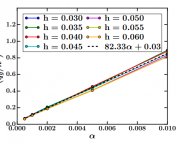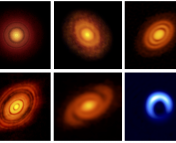- Paper Title: On The Evolution of the Snow Line in Protoplanetary Disks (arxiv: 1207.4284)
- Authors: R. G. Martin, M. Livio
- First Author’s Affiliation: Space Telescope Science Institute, Baltimore, USA
- Journal: Monthly Notices of the Royal Astronomical Society (accepted)
Introduction
This paper is aimed at addressing a puzzle in planet formation theory: why is the Earth so water-poor?
We often talk about the Earth as a water-rich planet; in fact, when astronomers refer to Earth-like planets, we generally mean worlds capable of hosting liquid water. However, in comparison to the gas giants, Earth is actually very water poor! The Earth is only 0.023% water by mass, while the outer solar system giants are as much as 40% water.
The explanation usually invoked to explain this situation is the concept of the “ice line”. At the beginning of the solar system, planets condensed from a disk of gas, dust and other materials circling the Sun; this is referred to as the “protoplanetary disk“. Beyond a certain distance from the Sun, water in the disk deposites into ice; within it, it sublimates into water vapor. The hypothesis is that water within the ice line will sublimate and be blown away by stellar winds, while water outside the ice line will deposit and aggregate into planetesimals. This scenario also explains why the gas giants formed far away from the Sun: beyond the ice line, they could gravitationally aggregate ice in addition to rock and consequently grow much faster. Observationally, we find ice-rich bodies past 2.7 AU and ice-poor bodies within; this implies that the ice line at the time of formation of the solar system was at that distance.
There’s just one problem: protoplanetary disk models (the mathematical theory and computer simulations behind planet formation) indicate that, as accretion slows and the disk cools, the ice line should migrate inwards – and end up well within the Earth’s orbit! According to the theory as it stands, the Earth should be water-rich and thus much bigger than actually is!
Method
This paper aims to address this discrepancy by addressing a particular assumption made by previous work: that the protoplanetary disk is turbulent, and that the magnetic-rotational instability (MRI) is responsible for this turbulence. However, this instability requires the disk to be ionized. While solar irradiation can ionize the disk very close to the star, further away cosmic rays are required for ionization – and if the disk is thick enough, then they can only ionize the surface. This can lead to a nonturbulent “dead zone” near the disk midplane. Furthermore, in this situation accretion is not steady-state; the amount of material accreting from the natal cloud onto the disk is not the same as the amount of material accreting from the disk onto the star. Thus, this scenario must be modeled in time-dependent fashion.
Results
Using these new assumptions, the authors then modeled the evolution of two protoplanetary disks: one with turbulence, and one without. The system parameters were chosen to make it comparable to the disk that formed our own solar system. Figure 1 presents the results:

Figure 1: Disk evolution models for a turbulent disk (left) and a disk with a dead zone (right). On the y-axis is distance from the star in AU, with a dotted line corresponding to the position of Earth. On the x-axis is time in years, starting at 10^5 years. Shaded areas show icy regions – i.e. where water can condense. The turbulent model has the ice line within an AU in just a million years, while the nonturbulent model has an ice-free region around an AU as well as an inner icy region.
Consistent with previous work, the turbulent model has the ice line crossing an AU just about a million years after disk formation – barely any time to form planets! By contrast, the model that includes a turbulence-free dead zone has an inner icy region and a central ice-free region. The latter is attributed to a small amount of turbulence due to self-gravity that heats the outer region of the dead zone.
This is very exciting – after t~1 million years, there is a growing ice-free region right around the Earth’s orbit! This resolves the discrepancy of previous models, and provides ample time for an ice-free Earth to evolve. Further work will be necessary to validate this model. If it proves consistent, then we may have reconciled planet formation theory with the water-poor Earth: Regions of low turbulence in the protoplanetary disk allow formation of water-poor terrestrial planets.
Also interesting is the icy inner region, which could potentially provide a habitat for gas giants to evolve closer in to the star. This is particularly relevant in the context of “Hot Jupiters”, extrasolar gas giants discovered orbiting very close in to their stars. Current theory assumes that they form in the outer reaches of their solar system and migrate inwards. A model having an icy region nearer to the star than the classical snow line allows them to form much closer in and thus have much less distance to migrate. The implications of this for planet formation models have yet to be explored, but in principle it could be good for the hunt for Earths. Gas giants migrating inwards have a tendency to scatter small Earth-like planets into the depths of space; if they form close to the star, there’s a better chance that other planets in the system could survive their migration!





Very cool! Nice write-up, Sukrit!